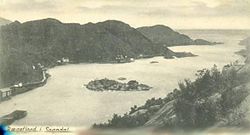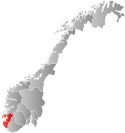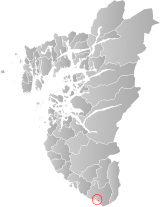Sogndal is a former municipality and small seaport (ladested) in Rogaland county, Norway. The municipality is located on the coast in the traditional district of Dalane. The 19-hectare (47-acre) municipality existed from 1845 until its dissolution in 1944 when it was merged into the municipality of Sokndal. It comprised the two harbor villages: the 7-hectare (17-acre) Sogndalsstranda and the 12-hectare (30-acre) Rægefjord. The river Sogndalselva reaches the ocean at Songdalsstranda.[2][3]
Sogndal Seaport Municipality
Sogndal ladested | |
|---|---|
 Postcard from 1910 of Rægefjord in Sogndal | |
 Rogaland within Norway | |
 Sogndal within Rogaland | |
| Coordinates: 58°19′22″N 06°17′04″E / 58.32278°N 6.28444°E | |
| Country | Norway |
| County | Rogaland |
| District | Dalane |
| Established | 1 Jan 1845 |
| • Preceded by | Soggendahl Municipality |
| Disestablished | 1 July 1944 |
| • Succeeded by | Sokndal Municipality |
| Administrative centre | Sogndalsstranda |
| Area (upon dissolution) | |
| • Total | 0.19 km2 (0.07 sq mi) |
| Population (1944) | |
| • Total | 311 |
| • Density | 1,600/km2 (4,200/sq mi) |
| Time zone | UTC+01:00 (CET) |
| • Summer (DST) | UTC+02:00 (CEST) |
| ISO 3166 code | NO-1107[1] |
History
editThe seaport village of Sogndalsstranda was built up around the Kjelland farm (historically spelled Kielland). The farm (named after a spring (kilde) situated there) was owned by the Kielland family, from which Alexander Kielland descended. This family left Sogndal in 1751 and established a successful firm in Stavanger. The Kielland farm can still be found there.[4] As is typical of older records, this farm is listed in historical records under a number of phonetically similar names: Kollandt in 1563, Kieldeland in 1567, Kuelandt in 1567, Tielland in 1610, Kielland in 1616, Kiedland in 1668 and finally fixing on Kielland since 1723.[5]
The villages of Sogndalsstranda and Rægestad are located near each other and together they were granted ladested rights in 1798. Together, this ladested was called Sogndal (historically spelled "Soggendahl"). This status gave them a monopoly on import and export of goods and materials in the port and in the surrounding district.[6]
On 1 January 1838, all of Norway was divided up into municipalities according to the formannskapsdistrikt law. The ladested of Sogndal was put into the municipality of Sokndal. In 1845, the ladested of Sogndal was separated from Sokndal and became a municipality of its own. Initially, Sogndal ladested had a population of 348 while the rural Sokndal municipality that surrounded it had a population of 2,819. In 1875, the population of Sogndal had grown to 526, but decreased to 473 in 1885. On 1 July 1944, Sogndal was merged back together with Sokndal municipality, losing its small seaport status. Prior to the merger, Sogndal had a population of 311.[7]
Name
editThe municipality (originally the parish) is named after the Soknedalen valley (Old Norse: Sóknardalr) since the first Sokndal Church was built there. The first element is the genitive case of the river name Sókn (now Sokno). That river name is derived from the verb sœkja which means "to seek" or "to strive for". The last element is dalr which means "valley" or "dale". Thus, the meaning is "the valley with the river which seeks (finds/forces) its way". Before 1918, the name was written "Sogndal" or "Soggendahl". This municipality was a ladested called Sogndal ladested, but it was surrounded by a rural municipality with the same name called Sogndal herred.[8]
Government
editWhile it existed, this municipality was responsible for primary education (through 10th grade), outpatient health services, senior citizen services, unemployment, social services, zoning, economic development, and municipal roads. During its existence, this municipality was governed by a municipal council of directly elected representatives. The mayor was indirectly elected by a vote of the municipal council.[9]
Municipal council
editThe municipal council (Bystyre) of Sogndal was made up of 12 representatives that were elected to three-year terms. The party breakdown of the final municipal council was as follows:
| Party name (in Norwegian) | Number of representatives | |
|---|---|---|
| Local List(s) (Lokale lister) | 12 | |
| Total number of members: | 12 | |
| Note: Due to the German occupation of Norway during World War II, no elections were held for new municipal councils until after the war ended in 1945. | ||
| Party name (in Norwegian) | Number of representatives | |
|---|---|---|
| Local List(s) (Lokale lister) | 12 | |
| Total number of members: | 12 | |
| Party name (in Norwegian) | Number of representatives | |
|---|---|---|
| Local List(s) (Lokale lister) | 12 | |
| Total number of members: | 12 | |
| Party name (in Norwegian) | Number of representatives | |
|---|---|---|
| Local List(s) (Lokale lister) | 12 | |
| Total number of members: | 12 | |
| Party name (in Norwegian) | Number of representatives | |
|---|---|---|
| Local List(s) (Lokale lister) | 12 | |
| Total number of members: | 12 | |
| Party name (in Norwegian) | Number of representatives | |
|---|---|---|
| Local List(s) (Lokale lister) | 12 | |
| Total number of members: | 12 | |
| Party name (in Norwegian) | Number of representatives | |
|---|---|---|
| Local List(s) (Lokale lister) | 12 | |
| Total number of members: | 12 | |
See also
editReferences
edit- ^ Bolstad, Erik; Thorsnæs, Geir, eds. (26 January 2023). "Kommunenummer". Store norske leksikon (in Norwegian). Kunnskapsforlaget.
- ^ Store norske leksikon. "Sogndal – ladested" (in Norwegian). Retrieved 6 July 2016.
- ^ Helland, Amund (1888). "Sogndal by". XI Stavanger amt. Norges land og folk (in Norwegian). Kristiania, Norway: H. Aschehoug & Company. p. 92. Retrieved 3 July 2022.
- ^ Stagg, Frank Noel (1958). South Norway. George Allen & Unwin, Ltd.
- ^ Kielland, Gabriel Wilhelm (29 August 2002). "Opprinnelsen" (in Norwegian).
- ^ Brandsberg, Reidar (1988). Sogndal Ladested, Sokndal og Eigersund - i eldre og nyere tid (in Norwegian). Egersund: Fuglseth bok- og offsettrykkeri. ISBN 9788299181303.
- ^ Jukvam, Dag (1999). Historisk oversikt over endringer i kommune- og fylkesinndelingen (PDF) (in Norwegian). Statistisk sentralbyrå. ISBN 9788253746845.
- ^ Rygh, Oluf (1915). Norske gaardn avne: Stavanger amt (in Norwegian) (10 ed.). Kristiania, Norge: W. C. Fabritius & sønners bogtrikkeri. p. 1.
- ^ Hansen, Tore; Vabo, Signy Irene, eds. (20 September 2022). "kommunestyre". Store norske leksikon (in Norwegian). Kunnskapsforlaget. Retrieved 1 January 2023.
- ^ "Kommunevalgene og Ordførervalgene 1937" (PDF) (in Norwegian). Oslo: Statistisk sentralbyrå. 1938. Retrieved 14 July 2020.
- ^ "Kommunevalgene og Ordførervalgene 1934" (PDF) (in Norwegian). Oslo: Statistisk sentralbyrå. 1935. Retrieved 31 July 2020.
- ^ "Kommunevalgene og Ordførervalgene 1931" (PDF) (in Norwegian). Oslo: Statistisk sentralbyrå. 1932. Retrieved 31 July 2020.
- ^ "Kommunevalgene og Ordførervalgene 1928" (PDF) (in Norwegian). Oslo: Statistisk sentralbyrå. 1929. Retrieved 31 July 2020.
- ^ "Kommunevalgene og Ordførervalgene 1925" (PDF) (in Norwegian). Oslo: Statistisk sentralbyrå. 1926. Retrieved 31 July 2020.
- ^ "Kommunevalgene og Ordførervalgene 1922" (PDF) (in Norwegian). Oslo: Statistisk sentralbyrå. 1923. Retrieved 31 July 2020.
- ^ "Kommunevalgene og Ordførervalgene 1919" (PDF) (in Norwegian). Oslo: Statistisk sentralbyrå. 1920. Retrieved 31 July 2020.